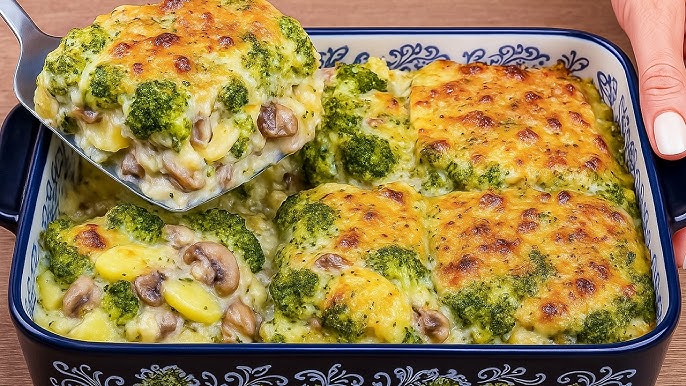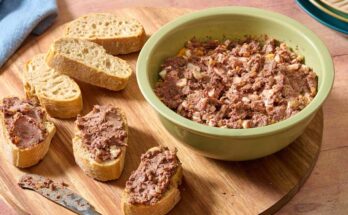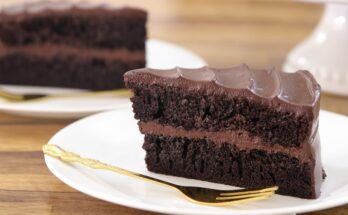Vegetable Casserole Recipe: Ever had one of those days where all you want is something warm, comforting, and easy to make? Enter the vegetable casserole. It’s the ultimate one-dish wonder—hearty, healthy, and endlessly customizable. Whether you’re feeding a crowd, using up leftover veggies, or just craving something cozy, this dish has your back. Think of it as the big cozy sweater of meals—filling, colorful, and full of good stuff.
Vegetable casseroles aren’t just about ease; they’re also a smart way to pack in a ton of nutrients in one go. With endless variations, you can go classic, Mediterranean, spicy Tex-Mex, or creamy and cheesy. And don’t worry if you’re vegan or gluten-free—you can adapt it easily. Best of all, it reheats like a dream, making it ideal for meal prep or lazy leftovers the next day.
In this step-by-step guide, I’ll walk you through making the ultimate vegetable casserole from scratch. We’ll break it down into bite-sized steps so even beginners can follow along. Get ready to chop, layer, and bake your way to comfort food heaven.
Ingredients You’ll Need
A good casserole starts with great ingredients. The beauty of this recipe is that it’s super flexible. You can mix and match based on what’s in your fridge or what’s in season. But here’s a solid base list to get you going:
Vegetables:
- 2 cups broccoli florets
- 2 carrots, peeled and sliced
- 1 zucchini, sliced
- 1 bell pepper, chopped
- 1 cup spinach or kale
- 1 onion, diced
- 2 cloves garlic, minced
Optional Add-ins:
- 1 cup mushrooms
- 1 cup corn or peas (frozen works fine)
- 1 cup cooked lentils or chickpeas for added protein
Sauce Base:
- 1 cup cream or plant-based milk (like almond, oat, or coconut)
- 2 tbsp flour (or cornstarch for gluten-free)
- 1 cup shredded cheese or vegan cheese
- 2 tbsp olive oil or butter
- Salt and pepper to taste
- 1 tsp paprika
- ½ tsp thyme
- ½ tsp oregano
Toppings (Optional but delicious):
- Extra cheese or breadcrumbs
- Chopped parsley or chives for garnish
This lineup gives you a creamy, cheesy, veggie-packed casserole. You can swap the cheese with nutritional yeast if you’re dairy-free or go all-in with mozzarella and cheddar for a cheesy finish.
Kitchen Tools Required
Before you dive into prep, make sure you have these essentials on hand. Nothing’s worse than realizing halfway through that your casserole dish is still at your friend’s house!
1. A large baking dish (9×13 inch is standard): This will hold all your layered veggies and sauce comfortably.
2. Sharp knife and cutting board: You’ll be chopping a good variety of veggies, so a reliable knife is key.
3. Large mixing bowl: Perfect for tossing veggies in seasoning or pre-mixing ingredients.
4. Saucepan: If you’re making a béchamel or cheese sauce, this will come in handy.
5. Measuring cups and spoons: For accuracy—especially with sauces and spices.
6. Whisk or spoon: To stir your sauce and keep it lump-free.
7. Aluminum foil or a lid for baking: Covering your dish for the first part of baking keeps moisture in and prevents over-browning.
These basic tools ensure your cooking process is smooth from start to finish. You don’t need anything fancy—just reliable and clean utensils.
Preparation Steps
Step 1 – Wash and Chop the Vegetables
Cleanliness is the first step to a tasty casserole. Rinse all your vegetables thoroughly under cold running water. Scrub root vegetables like carrots and peel them if you prefer. Then, slice or dice everything into uniform sizes—this helps them cook evenly.
- Broccoli: Cut into bite-sized florets.
- Carrots and zucchini: Thinly slice so they soften in the oven.
- Onion and garlic: Dice finely to spread the flavor evenly.
- Spinach or kale: Roughly chop and remove tough stems.
Once chopped, place them in a large bowl. This step may seem simple, but it sets the foundation. Beautifully chopped, fresh vegetables = a visually stunning and delicious casserole.
Step 2 – Pre-cook Harder Veggies
Some vegetables take longer to cook, like carrots or broccoli. To make sure everything bakes evenly, it’s a smart move to pre-cook the tougher ones.
- Steam or lightly sauté the carrots and broccoli for about 5 minutes. They should be slightly tender but still have a bit of crunch.
- Drain and set aside.
Why do this? It prevents undercooked chunks in your casserole and keeps the texture balanced. Your zucchini and spinach don’t need this step—they’re soft enough to cook in the oven.
Step 3 – Prepare Sauce or Seasoning Mix
Now for the magic maker—the sauce. You can go creamy, cheesy, or even tomato-based depending on your taste. Here’s a quick and easy cheesy white sauce:
- Heat olive oil or butter in a saucepan over medium heat.
- Whisk in flour to create a roux, stirring constantly until smooth.
- Slowly pour in the milk, whisking to avoid lumps.
- Add salt, pepper, paprika, thyme, and oregano to taste.
- Once the sauce thickens, stir in cheese until it melts.
Want it dairy-free? Use olive oil, plant-based milk, and skip the cheese or swap it for nutritional yeast or vegan cheese.
This sauce should be creamy but pourable. If it gets too thick, just add a splash more milk.
Step 4 – Layer the Ingredients
Now that everything is prepped and ready, it’s time to build your masterpiece! Think of this step as laying down the foundation for your casserole. Here’s how you can do it for the best flavor and texture:
- Grease your baking dish with a little olive oil or butter to prevent sticking.
- Spread a thin layer of the sauce on the bottom to start.
- Layer your vegetables evenly—start with denser veggies like carrots and broccoli, then add the softer ones like zucchini, bell peppers, spinach, and onions.
- Add protein or extras (like lentils or chickpeas) between layers if using.
- Pour some sauce over each layer to ensure everything gets coated and flavorful.
- Continue layering until you’ve used up all the veggies and sauce.
Make sure to finish with a generous drizzle of sauce on top. You want every bite to be packed with flavor. The layers will cook down a bit, so don’t worry if your dish looks full at this stage.
Step 5 – Add Cheese or Vegan Substitute
Here comes the real comfort food moment—adding that melty, golden topping. Cheese lovers can go wild here, but if you’re keeping it vegan, no worries, there are great substitutes.
- Traditional option: Use shredded cheddar, mozzarella, or a cheese blend. Add a mix of cheeses for depth of flavor.
- Vegan option: Use store-bought vegan cheese or sprinkle nutritional yeast for a cheesy flavor without dairy.
- Crunchy topping bonus: Mix breadcrumbs with a little olive oil or melted vegan butter and sprinkle on top for a crispy finish.
The topping adds both flavor and texture. A golden, bubbly crust is the secret to that crave-worthy bite.
Step 6 – Cover and Bake
Time to let the oven do its thing. Set your oven to 375°F (190°C) and follow these steps:
- Cover your casserole with foil for the first 25–30 minutes. This helps steam the veggies and keeps everything moist.
- After that, uncover and bake for an additional 15–20 minutes. This gives the top that perfect golden color and lets any extra moisture evaporate.
- When done, the casserole should be bubbling, with a slightly crisp top and soft, tender veggies underneath.
Let it cool for at least 10 minutes before serving. This rest period helps the layers settle and makes it easier to cut clean servings.
Serving Suggestions
This vegetable casserole is super versatile when it comes to serving. Whether you want it as a main dish or a hearty side, here are some delicious ways to enjoy it:
- As a main: Pair with a side of crusty bread or a simple green salad. A drizzle of balsamic glaze or fresh herbs takes it to another level.
- With protein: Serve alongside baked tofu, grilled chicken, or a piece of salmon for a complete meal.
- For brunch: It doubles beautifully as a breakfast bake—just add a fried egg on top!
Storing leftovers:
- Refrigerate in an airtight container for up to 4 days.
- Reheat in the oven or microwave.
- It also freezes well—just wrap it tightly and it’ll keep for up to 2 months.
This dish tastes even better the next day as the flavors meld together. It’s meal prep gold!
Tips for a Perfect Vegetable Casserole
A good casserole is all about balance—flavor, texture, and moisture. Here’s how to get it just right every time:
1. Avoid sogginess
- Don’t overdo the sauce. It should coat, not drown the veggies.
- Pre-cook high-moisture veggies like zucchini to prevent a watery bottom.
2. Enhance flavor
- Season each layer lightly. A pinch of salt and pepper goes a long way.
- Add a splash of lemon juice or a sprinkle of chili flakes for extra zing.
3. Make it kid-friendly
- Dice veggies small and blend them with familiar favorites like cheese or pasta.
- Use a creamy sauce base and top with their favorite shredded cheese.
4. Use what you have
- Almost any veggie works. Got sweet potatoes? Toss them in. Leftover roasted veggies? Perfect!
- Don’t be afraid to experiment with sauces—think tomato base, pesto drizzle, or curry-flavored cream.
By keeping these tips in mind, you’ll never go wrong with a vegetable casserole. It’s flexible, forgiving, and always satisfying.
FAQs about Vegetable Casserole Recipe
1. Can I freeze vegetable casserole?
Absolutely! Vegetable casseroles freeze beautifully. Just let it cool completely, wrap tightly in foil or a freezer-safe container, and freeze for up to 2 months. To reheat, thaw in the fridge overnight and bake at 350°F (175°C) until heated through.
2. What’s the best cheese for casseroles?
It depends on the flavor you’re after! Cheddar gives a sharp, rich taste; mozzarella melts beautifully; and a blend of parmesan and gouda adds depth. For a tangy twist, goat cheese or feta work great too. And if you’re vegan, go for dairy-free cheese alternatives or nutritional yeast.
3. Can I use frozen vegetables?
Yes! Frozen vegetables are a time-saver and work wonderfully. Just make sure to thaw and drain any excess water before using to avoid sogginess in your casserole.
4. How long does it keep in the fridge?
A properly stored vegetable casserole will stay fresh in the fridge for up to 4 days. Make sure it’s in an airtight container or tightly covered to preserve flavor and moisture.
5. Is it gluten-free?
It can be! Just swap out regular flour for gluten-free flour or cornstarch in the sauce. Also, check your toppings (like breadcrumbs or pre-shredded cheese) to ensure they’re gluten-free.
Conclusion
This step-by-step guide breaks the whole process down into manageable, easy-to-follow steps, so whether you’re a beginner or a seasoned cook, you can confidently whip up a delicious and wholesome vegetable casserole. From prepping the freshest vegetables to mastering the layering and baking process, this dish rewards your effort with warmth and flavor in every bite.
So next time you find yourself staring at a bunch of veggies in your fridge wondering what to make, remember this casserole. It’s more than just a recipe—it’s a go-to comfort dish, packed with nutrition, flavor, and heart.



